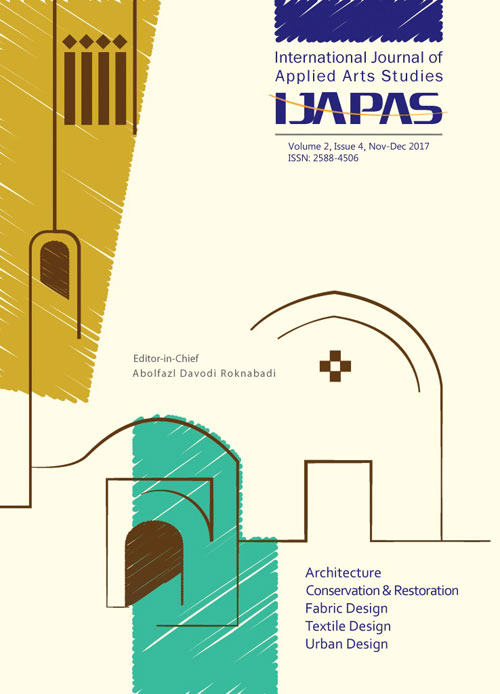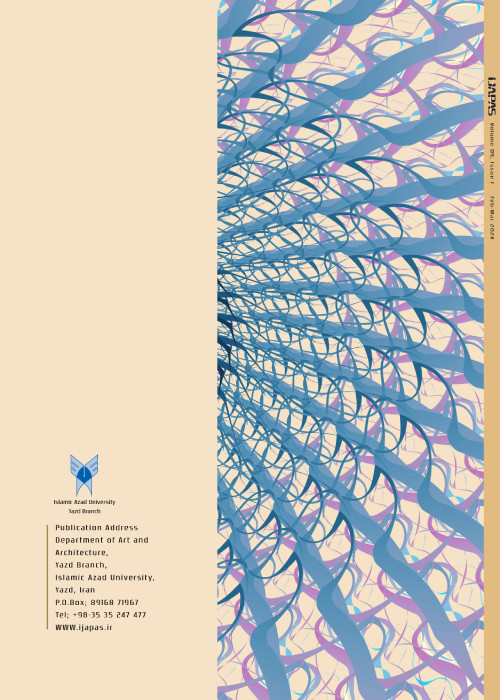فهرست مطالب

International Journal of Applied Arts Studies
Volume:2 Issue: 4, Nov-Dec 2017
- تاریخ انتشار: 1396/09/11
- تعداد عناوین: 6
-
Pages 7-14Contamination is an unwanted threat, which affects the health and the artistic features of a piece of textile. One of the most important concerns in the area of protection of historical woven fabrics is the presentation and use of safe materials and methods for the historic works. So far, many researchers have been working on this field and have caused a lot of changes in this field. The purpose of this research is to apply Acanthophyllum extract to the cleaning and washing of historical cotton fabrics. For this purpose, after preparing the Acanthophyllum, using the Soxhlet method, the extract of hydro-alcoholic was obtained. The extract was applied, as a detergent, to the prepared contaminated samples in the washing step. In the washing process, all constant independent variables were concerned, and only three concentrations of extract, washing frequency and times were considered in the design of the test, using a Central Composite Design (CCD). The detection of delta DE* by spectrophotometer as a dependent variable expresses the effect of extract cleansing rate. The results show that extract concentrations, washing frequency and time are most effective in cleaning the contamination. However, the adopted washing process and the applied materials had the least impact on reducing the strength of the fabric.Keywords: Acanthophyllum, Historical Textile, Clearing, Washing, Cotton, CCD
-
Pages 15-24Considering increasing development of nano-technology science and its wide use in most industries, textile industry was not excluded and manifested its capability in all fields accompanied with other sciences and achieved remarkable progress. Since interdisciplinary scientific research causes developing sciences and is attended by many specialists, in this research a beneficial step was provided applying dress design and textile chemistry sciences for more productivity of interdisciplinary discussions. In this study, the design of the drivers’ uniform and their self-cleaning property were analyzed. In a way that; first, cotton fabric samples were treated using TiO2 nanoparticles and poly carboxylic agent. Then, cotton fabric self-cleaning amount were evaluated and optimized. Based on the obtained results, drivers’ uniform design with self-cleaning property against chemical and natural stains was gained, utilizing optimized amounts of TiO2 nanoparticles. Therefore, the dress design applying nanotechnology discussions was effectively capable of having self-cleaning property in order to discolor natural color stains like tomato, sour cherry water, chocolate milk, gasoil, grease, oil, and chemical blue (C.I. Reactive Blue 19) and green (C.I. Direct Green 1) regarding scientific principles.Keywords: Dress Design, Drivers, Self-Cleaning, TiO2 Nanoparticles
-
Pages 25-32Medians were the only Aryan tribe that defeated the great Assyrian empire through relying on their unity, releasing many tribes and dynasties from the aggressive and offending Assyrians captivity situations. It can definitely be said that horse breeding and ranching were quite developed among them, farming was common in the outskirts, and they were well informed about metal working with bronze. The Kurds are among the old Iranian races, who according to many researchers are the successors of Medians. Relying on the results of the present study, with only a little change, Kurdish clothing can be said to be the same as Median clothing where in some cases, for instance, the height of the clothing is shortened and extended from the knees to the waist, or the form of the waist sash that is slightly changed nowadays from the Median shape to the sash shape; it should also be said that all the transformations have been towards a more convenience and more appropriate function. Thus, regarding the historical basis, convenience and agility, the considered design and sewing, the recognition, and the models can be effective in these outfits. Reconsidering and restoring Median and Kurdish equestrian clothing with traditional design and sewing can lead to increased exporting of these outfits and reducing the importation of these clothes. This study is an applied research and the data are obtained by field-library investigations.Keywords: Clothing Design, Iranian Clothing, Median Clothing, Kurdish Clothing, EquestrianClothing*
-
Pages 33-38Art in a broader sense refers to an activity that is spontaneous and self-restrained. Over many years, traditional art has represented its concepts with motifs and colors, which reflects the consistency and harmony with nature. On the other hand, there is modern art, which refers to trends of artistic improvement and modernism being affected by recent thoughts, and one wonders whether traditional art may fade away with the presence of new ideas and thoughts. Therefore, considering both traditional and modern art, one of the strategies that represent significance and prevent the decline of any one will be combination of the two arts, to harmonize with nature along with novelty and modernism.
In this regard, traditional colors and patterns were used in the present study in order to design textile with the combination of modern art, since the art of making fabric has been accompanied with creativity and innovation. Therefore, Poly Vinyl Alcohol material has been used with the feature of being soluble in water instead of ordinary cloth.Keywords: Traditional Art, Modern Art, Making Fabric, Poly Vinyl Alcohol Textile -
Pages 39-52The present study focuses on the impact of technology on German's contemporary architecture, concentrating on the BMW's museum construction. The researchers' approach is descriptive analytic resulting in what defines modern architecture of BMW museum as technology. In fact, studying the impact of industry on building and architecture, industrial revolution and technology and production becoming mechanical have proved the role of technology in “nature” and “form” of architecture. Applying modern technology on the construction of automobile museum buildings, Germans proved, all over the world, their scientific, political and industrial achievements as the most developed country in Europe. The form of these buildings shows new characteristics and a hormonal flexibility with industry and technology as a result of technology improvements. The changes in constructing process, manufacturing, material usage and building systems enable architecture to shape new spaces in accordance with “styles of lives”, and create desirable places to show the attitude of modern man and his achievements. In other words, man can possess a better and more profound understanding of the world by using the forms which enjoy modern technology.Keywords: Symbol, Contemporary Architecture, Technology, Automobile Museum, Space-Time
-
Pages 53-64Urban spaces are an important element in urban form. Urban squares, for example, have been a space for social and group activities for a long time, in order to create vitality in space. The presence of people in the city squares increases the vitality of that area. The Palestine Square of Zahedan is one of the oldest squares of this city. Unfortunately, over time this square has lost its vitality. The study was conducted based on descriptive-analytical method. Library and field survey was conducted for data collection. The population sample includes the residents and the passerby near the Palestine Square of Zahedan. The study evaluates the criteria of vitality as an indicator to redesign the square with proposed design alternatives. Questionnaire, field observation and interviews via EXCEL software and SWOT technique was implemented for decision making. Analytical Hierarchical Process technique was used for designing and evaluating the alternatives.Keywords: Redesign, Urban Space, Vitality, Palestine Square, Zahedan


